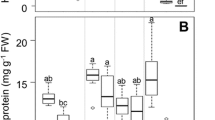Abstract
A recurring theme in defense allocation theories is that defenses are costly. Most studies that attempt to quantify a cost of defense seek to establish a trade-off between a component of plant fitness and the level of a constitutive defense. Such estimates are ambiguous because they cannot discount the cost of traits that are correlated with defense but are not themselves defensive. We examined the effects of damage-induced synthesis of furanocoumarins, known defense compounds, on the growth of wild parsnip. Plants that had 2% of their leaf area removed accumulated 8.6% less total biomass and 14% less root biomass than intact plants over a 4-week period. We also found that this small amount of leaf damage significantly reduced net photosynthetic rates 0.5 h after damage; the effect was temporary, as photosynthetic rates were no longer significantly different after 48 h. Lastly, we found that increases in respiration rates associated with damage coincided spatially and temporally with increases in furanocoumarin production, and that respiration increases were phenotypically correlated with furanocoumarin production. When damage-induced changes in furanocoumarin content and respiration rates were expressed in glucose equivalents and compared, the energetic cost of furanocoumarin production (12.6 μg glucose cm−2) accounted for all of the increase in respiration (12.0 μg glucose cm−2). A comparison of other secondary compounds in damaged and intact leaflets revealed that myristicin, a furanocoumarin synergist, is the only other compound aside from furanocoumarins that is inducible. The inducible defense system of wild parsnip thus appears to involve a small subset of secondary compounds. Synthesis of these compounds is tightly linked to damage-induced rates of respiration. Because the negative impact that damage had on the rate of net photosynthesis was short-lived, the impact of damage on growth observed in this study was likely due to the cost of furanocoumarin synthesis elicited by damage rather than the loss of photosynthetic tissue caused by damage.
Similar content being viewed by others
Author information
Authors and Affiliations
Additional information
Received: 4 April 1996 / Accepted: 29 August 1996
Rights and permissions
About this article
Cite this article
Zangerl, A., Arntz, A. & Berenbaum, M. Physiological price of an induced chemical defense: photosynthesis, respiration, biosynthesis, and growth. Oecologia 109, 433–441 (1997). https://doi.org/10.1007/s004420050103
Issue Date:
DOI: https://doi.org/10.1007/s004420050103




